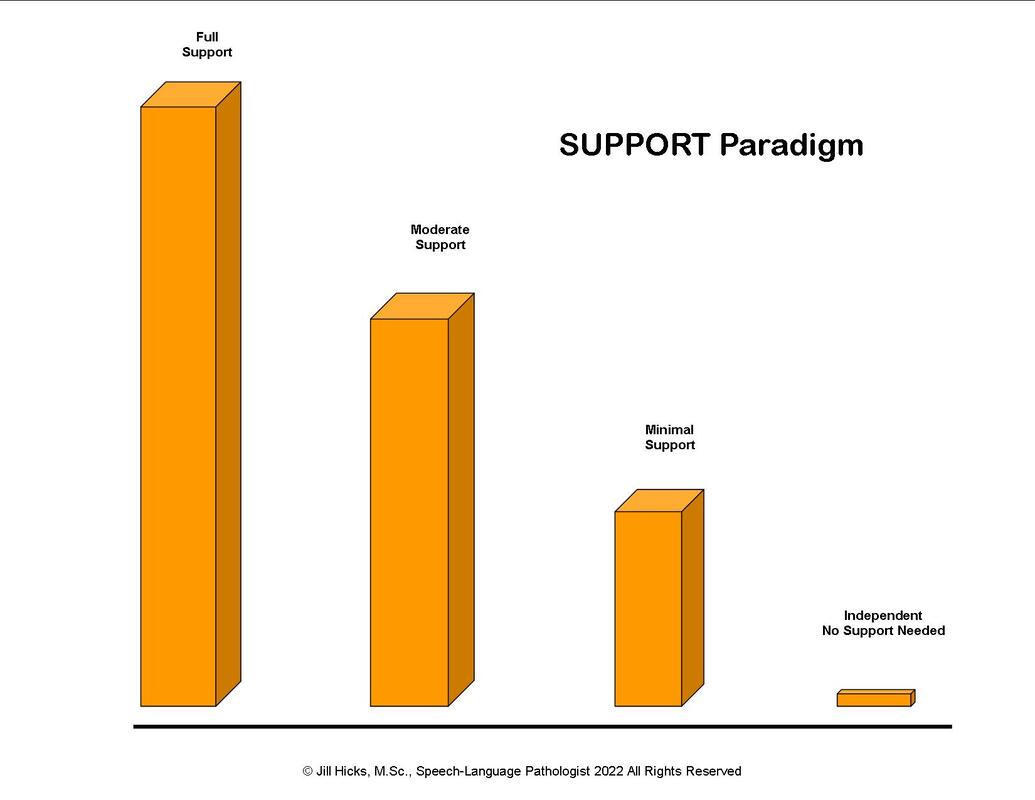How providing the right amount of support enhances skill development. Written by Jill Hicks, November 2022As parents and professionals working with children with Down syndrome, we want to help them succeed. In this blog post I’m going to address the reciprocal dance between skill development and support. I like to think of skills and support as being two separate but related paradigms. They each fit on a continuum from less to more. And they have direct influence on each other. Said another way, the level of a skill or ability directly influences how much support should be provided. And how much support is provided will directly affect skill development. So what is the optimal amount of support? And how do we know how to adjust the amount of support we give? Since I’m a speech-language pathologist it is most relevant for me to give an example regarding speech development. First of all we’ll look at the Skill paradigm. This example reflects how much ability or skill the child has producing a specific phoneme (speech sound). As the above illustration shows, the child moves from the most basic level of ability, which is production of the sound in isolation (by itself). Once the child can accurately produce the sound in isolation, we move to saying the sound in a word, then to saying the sound in a word in a sentence. And finally, the child uses the sound in a word, in a sentence during spontaneous speech (in a real life context). There are often substeps to the above Skill paradigm illustration which your child’s SLP will be aware of and guide you through. Some examples of substeps are closer and closer approximations to saying the sound in isolation, saying the sound in syllables, saying the sound in one syllable words before multisyllabic words, saying the sound in different positions in words, etc. Moving from producing the sound in isolation to using the sound in words in sentences in spontaneous speech can take months or even years depending on the child and the sound. Each step is a significant achievement and needs to be celebrated. Practice eliciting the sound in isolation, and at the word and sentence level are often initially done during “structured practice time”. This is because it takes a lot of focus to learn a new skill. During structured practice time, we can offer time to focus on speech work, without distractions, or time pressure. But eventually, and ultimately, we have to be intentional about making sure the new sound is carried over to real life speaking situations. So now let’s talk about the Support paradigm. The Support paradigm shows how much support we need to give a child during skill development. It’s important that the goals we choose are at exactly the right level. A goal that’s too easy means the child already has that skill. A goal that’s too hard means that even with support the child has a very low rate of correct responses when trying to achieve the skill. Let’s assume our speech sound goal is at the right level. This is what the Support paradigm looks like: The Support paradigm moves from the child needing full support to needing no support. Full support is when numerous supports or cueing methods are used, for example, to elicit a sound. Full support can mean hearing the adult model the sound, seeing the Sign Sound for the sound, watching how the mouth moves, producing the sound with the SLP while looking in a mirror together, getting verbal cueing (such as “smile” or “keep your lips together”), etc. For moderate support the child still needs several cueing methods to achieve success. For minimal support the child needs only one or two cues, or needs cues only intermittently to achieve success. And finally, Independence means the child is independent in producing the sound without any cueing required. It is important to explicitly reduce and then withdraw support to increase independence. Independence with a skill is our ultimate success.
One of the most important concepts to embrace is how the Skill and Support paradigms interact. As you move up the Skill continuum, each new level may initially require more support, and move through the Support continuum. For example, once a child learns to say a certain sound such as /m/ in words, it can be a significant hurdle to then ask the child to use that word in a phrase or sentence. Instead of just having to concentrate on saying the sound in a single word, the child now has to think of all the sounds in all the words in the sentence, get the words in order, and figure out the meaning. These “distractions” make it harder to concentrate on articulation of the target sound in the word. But fortunately, we can provide more support at this new Skill level, so the child has a greater likelihood of success. The amount of support we provide is directly linked to how much support the child needs. Success is important. We want our children with Down syndrome to practice the right way. Each time the child says /m/ incorrectly, they are cementing a misarticulation in their memory. Each time the child says /m/ correctly, they are cementing correct production of the sound in their memory, which makes it easier and more likely to produce the correct sound next time. Success builds upon success. It all starts with very carefully chosen goals, and an in depth understanding of how the Skill and Support paradigms interact to enhance learning, independence, and success :)
0 Comments
Leave a Reply. |
For a powerful resource to help your child speak
AuthorJill Hicks is the mother of a child with Down syndrome and a speech-language pathologist. Her passion is to empower others to help people with Down syndrome. WhArticles
|





 RSS Feed
RSS Feed
